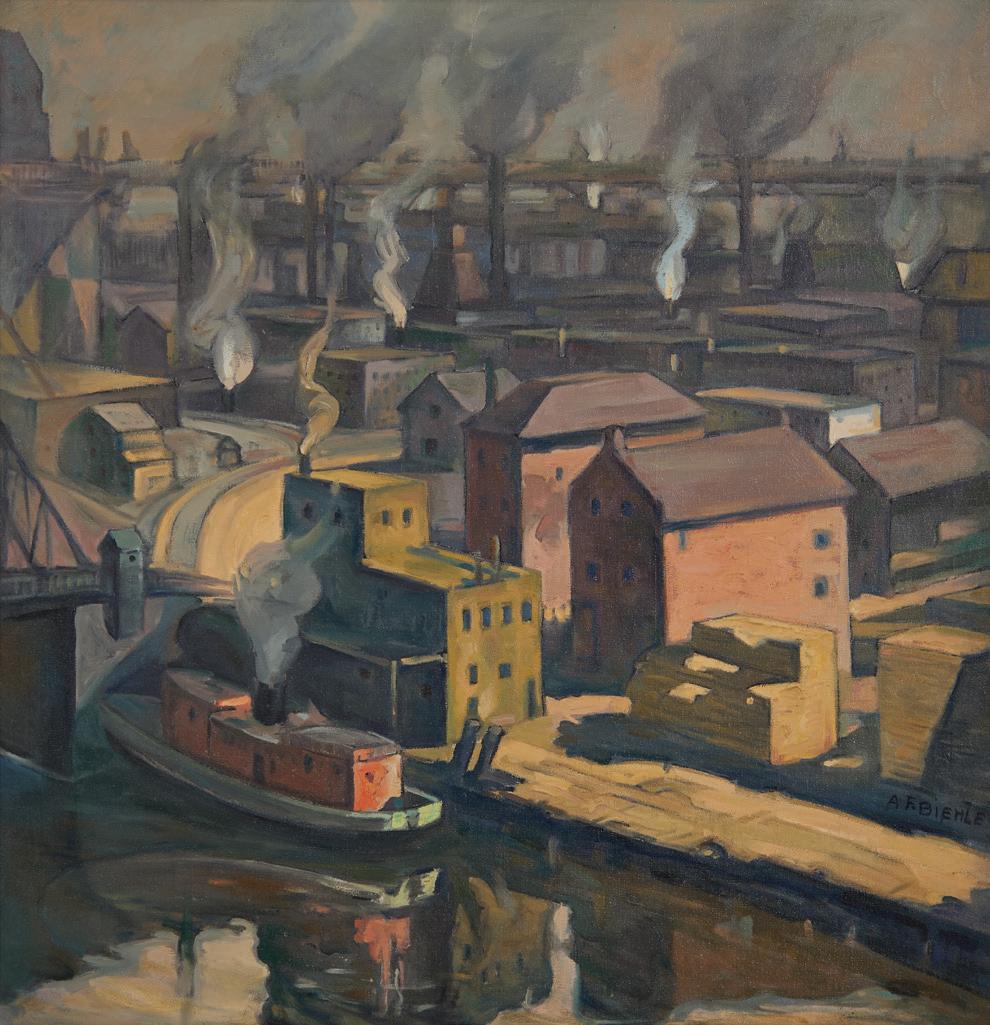
Frederick Biehle (1885-1979)



Frederick Biehle (1885-1979)

OCTOBER - DECEMBER, 2025
by Michael Wolf Essay by William H. Robinson, PhD
August Frederick Biehle: Reckoning with Modernism
Published in conjunction with the exhibition at WOLFS Gallery
October 10 – December 30, 2025
© 2025 McKinley Madison Publishing House, LLC. All rights reserved. No part of this publication may be reproduced, stored in a retrieval system, or transmitted in any form or by any means, electronic, mechanical, photocopying, recording, or otherwise, without prior written permission from the publisher.
Essays © 2025 William H. Robinson and Michael Wolf
ISBN: 979-8-9933316-0-7
Library of Congress Control Number: 2025921246
Published by McKinley Madison Publishing House, LLC
Cleveland, Ohio
In association with WOLFS Gallery
Contact: info@mmphpub.com | www.mmphpub.com
Printed in the United States of America First Edition


by Michael Wolf
I’ve had the good fortune of spending most of my long career involved with works of the Cleveland School. So it is a true joy for me to be able to introduce this long in coming exhibition of the work of August Frederick Biehle. In that Biehle became one of the most important founding members of the Cleveland School, the exhibition in and of itself is a milestone for our gallery. For such a momentous occasion, it was only appropriate to enlist the support of one of Cleveland’s most esteemed curators and experts on the history of Cleveland art.
Among his many achievements while at the Cleveland Museum of Art, William H. Robinson wrote and curated Transformations in Cleveland Art 1796-1946 in 1996, the gold standard on the history of Cleveland art. In the following concise essay, Bill has brought forth the essence of this fine and complicated artist, while touching on the spirit and intensity of Cleveland’s uniquely accomplished arts community at this time and its important influence on Biehle’s work.
Aided by the support of the Biehle family, the administrative genius of Megan Arner and Bill’s curatorial magic, we proudly bring you:
August Frederick Biehle: Reckoning with Modernism
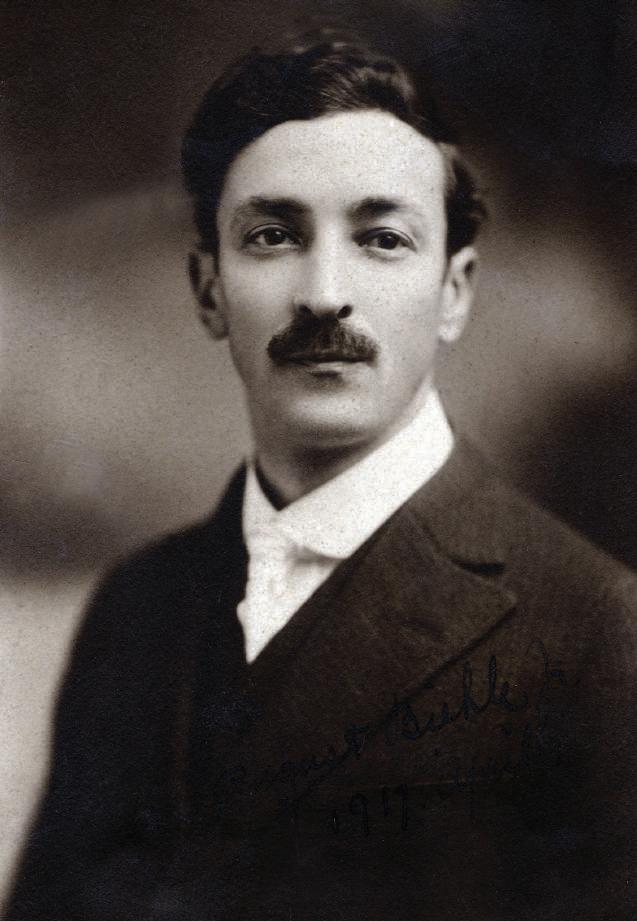
by William H. Robinson, PhD
In the early years of the twentieth century, a distinctive modernist movement emerged in Cleveland, Ohio that has received scant notice in standard surveys of American art. August Frederick Biehle, Jr. (1885-1979), the son of German immigrants, was one of its leaders. Active for over seven decades, Biehle produced a remarkable body of work that still awaits full recognition. He absorbed the most recent developments in avant-garde art on trips to Europe, yet always returned home to pursue his personal and professional life in Ohio. His enduring legacy rivals, if not surpasses, that of many better-known contemporaries.1
During Biehle’s formative years, Cleveland was one of the fastest-growing cities in America. Home to “Millionaires’ Row,” the nation’s wealthiest street, the city was a thriving center of industry and commerce—oil refineries, steel mills, auto manufacturing, commercial lithography, and poster design. The booming economy enabled Biehle to earn a comfortable living as a commercial lithographer. He survived the Great Depression without losing his home, sustained by occasional commercial commissions and WPA projects. His professional work provided the financial stability that allowed him to pursue modernist art on his own terms. His career parallels the path of other Cleveland modernists, most notably William Sommer and Charles Burchfield. While Burchfield moved to Buffalo in 1921 to work as a wallpaper designer, Biehle and Sommer remained in Cleveland, leading a thriving community of artists determined to forge their own path toward visionary modernism.
Biehle’s father, August F. Biehle, Sr. (1854–1918), emigrated from Freiberg in the German Rhineland to Cleveland in 1880, accompanied by his brother Frederick. They joined a bustling immigrant city filled with Germans, Italians, Irish, Hungarians, and other Eastern Europeans. Trained as master decorators, the Biehle brothers found abundant work painting interiors and murals in the city’s newly built mansions and commercial buildings.
August Jr. began drawing as a child. By age twelve, he was filling sketchbooks with nature studies and drawings of architectural ornament.2 From 1899 to 1902, he apprenticed with his father, learning stenciling, paint techniques, and design principles, and assisted his father with painting murals and interior decorations in buildings in Cleveland, St. Louis, and Chicago.
Seeking more advanced training, Biehle travelled to Munich in 1903 to study at the Kunstgewerbeschule—an arts and crafts school that integrated fine and applied arts. This renowned school was a center of Jugendstil (the “young style”), often compared to French Art Nouveau, yet distinct in its emphasis on uniting architecture, interior design, and graphic arts into a “total artwork.”
Jugendstil principles are evident in Biehle’s early watercolor Parrot (cat. 1), inscribed “A. Biehle München 1905” in the lower right. The brightly colored bird is set against a flat background with rhythmically placed branches.

Most striking is the heavy, sinuous outline encircling the parrot’s body—a reflection of Jugendstil’s “whiplash line,” used here to infuse the image with strength and energy. Rather than conventional academic modeling, Biehle integrated observation of nature with decorative abstraction, foreshadowing later developments in his art.
After receiving his diploma from the Kunstgewerbeschule, Biehle returned to Cleveland in 1905. In 1908, he became a color consultant at the Sherwin-Williams Company and sketched views of the Cuyahoga River seen from his office window at 605 Canal Road.3 He also ventured beyond his office and sketched along Scranton Road on the opposite side of the river. This industrial valley, lying just beneath the western edge of downtown Cleveland—popularly known as the Flats—was lined with steel mills and the oil refineries of John D. Rockefeller’s Standard Oil Company.
Fire Tug on the Cuyahoga (cat. 2) captures a dramatic view of ramshackle buildings and
smoke-belching chimneys in the Flats. Brilliant sunlight floods the buildings and water in the foreground, contrasting with a dark sky in the distance. Here, Biehle’s ability to shift from a refined decorative style to a gritty urban naturalism is on full display. The stark realism of this dark, sooty scene invites comparison with the paintings of the Ashcan artists who staged their first exhibition in New York City in 1908. Biehle admired Fire Tug on the Cuyahoga enough to produce two versions: a small oil on board around 1908, the year he began working at Sherwin-Williams, and the larger oil on canvas reproduced in this catalogue.4
Biehle returned to Europe in January 1911.5 In Paris, he visited art museums and attended drawing classes with fellow Cleveland artists William Zorach and Elmer Brubeck. But Biehle’s limited French left him feeling out of place, and he soon moved to Munich, a more welcoming city for an artist fluent in German. After several months of studying figure drawing and portrait painting at the Royal Academy of Fine Arts, he grew frustrated with his lack of progress and returned to the more progressive Kunstgewerbeschule, where he was given his own studio.
During his second stay in Munich, Biehle refined his decorative style. The flattened shapes and abstract patterning in Castle in Germany (cat. 5) have been compared to the early paintings of Wassily Kandinsky.6 The luminous colors also suggest inspiration in Bavarian glass painting. The flat, vertical space in a related painting, Scene in Southern Germany (cat. 6), together with the expressive hatchings of pure color in the foreground and sky, are reminiscent of Gustav Klimt’s landscapes, which Biehle may have known through the magazines Ver Sacrum and Die Graphischen Künste
Jugendstil artists abstracted natural forms not merely for formal design, but to infuse their images with symbolic meaning. Flowing lines and abstract color became metaphors for emotional states and ideas. Biehle’s Forest in Germany (cat. 8) embraces this approach of suggesting symbolic meaning through decorative design. While the trees reach dramatically upward, the moonlit sky illuminates the dark forest, forming pools of blue on the ground, evoking a mood of mystery and spirituality.
Biehle also painted outdoors in the countryside around Munich. His woodland views, such as House in the Moor near Munich (cat. 7), were influenced by “Die Scholle” (The Clod), a group of German artists known for their romanticized depictions of rural life. There may be another influence in Biehle’s paintings that has received less attention. In 1912, he attended the Sonderbund exhibition, a massive display of international modern art that sent shockwaves through Germany and inspired the 1913 Armory Show in America. The Sonderbund featured 125 works by Vincent van Gogh, whose surging brushstrokes, energetic drawing, and emotional intensity left a lasting impression on Biehle—an influence that resurfaced in his Ohio landscapes of the 1920s and 1930s.
Among the most consequential events in Biehle’s life was attending two exhibitions of the German Expressionist group “Der Blaue Reiter” (Blue Rider), held in Munich in 1911 and 1912. Led by Kandinsky and Franz Marc, the Blaue Reiter synthesized ideas from Fauvism, Cubism, and Futurism in their search for an art driven by “inner necessity” rather than outward appearances. Kandinsky associated the color blue with spirituality and the eternal. In 1912, Biehle purchased a copy of the group’s Blaue Reiter Almanac, featuring essays by leading theorists of avant-garde art, including Arnold Schönberg and David Burliuk. The

Almanac reproduced works by leading modern artists, most notably Van Gogh, Pablo Picasso, Henri Matisse, German Expressionists, and Russian Futurists. Avant-garde paintings were juxtaposed with African masks, Bavarian glass paintings, and other forms of so-called “naïve” art. Biehle returned to Cleveland with his copy and shared it with astonished colleagues.
Biehle returned to Cleveland and his job at Sherwin-Williams in the summer of 1912. In 1913, he began a three year apprenticeship under William Sommer at Otis Lithography Company, marking the start of his long career in commercial lithography. Biehle quickly developed a close relationship with Sommer, the city’s most renowned ultra modernist.
They spent weekends together painting around Sommer’s farmhouse in Brandywine, a rural community twenty-one miles south of the city. They were often joined by William Zorach, another lithographer at Otis, who had already absorbed Fauvist influences on visits to Paris.
Sommer, Biehle, and Zorach developed their own modernist styles before the Armory Show opened in New York in February 1913. The controversial exhibition traveled to Boston and Chicago, stirring howls of laughter and derision. Students in the Windy City held a mock trial of Matisse for committing “crimes against art” before hanging him in effigy. But something else was happening in Brandywine. The artists in Sommer’s circle were not content to follow others. Inspired by radical ideas in literature and philosophy, they were searching for their own synthesis—a visionary modernism that would convey the spiritual essence of a motif, an idea, an emotion.
This new ecstatic or mystical modernism appears in Biehle’s Brandywine Road (cat. 9). Brilliant rays of light radiate from the sky, while swirling lines animate the landscape and clouds. The large V shape in the foreground is echoed by the upside down V shape of the light rays, together forming a diamond or crystal in the center. Budding plants along the bottom surge upward like a chorus of souls rising in the fields. This impulse toward a spiritual or mystical modernism reached a new climax in Biehle’s The Deposition (cat. 10), depicting a man being laid to rest beneath a blue and purple cross and a blazing sunset, while Futurist “lines of force” penetrate the sky and landscape. The orange cloud above the cross stretches across the sky to suggest the arms of a robed figure striding forward. Biehle later noted on a postcard that he associated the landscape with Sommer’s farm.7 While the painting can be interpreted as representing the burial of Christ, it may also allude to a universal quest for spirituality.

In 1914, Biehle joined the Kokoon Klub, an organization of progressive artists founded by Sommer and Carl Moellman in 1911.8 The club rented facilities where members could paint from nude models, free from the dictates of conservative professors. The club also sponsored exhibitions, lectures, and social activities. In 1913, they organized the first of a series of Futuristic “Bals Masques” to raise funds for the club. These large costume parties, held annually from 1913 to 1946, became the center of Bohemian life in the city—notorious for promoting risqué behavior and provocative art. Biehle exhibited in at least eight Kokoon Klub exhibitions between 1915 and 1942. Elected president in 1929, he supported the club by designing posters and announcements for its activities. Sketch for a Kokoon Klub Souvenir/ Poster (cat. 14) is an imaginative rendering of a nude man with blue hair, perhaps humorously
alluding to a specific club member, while other nudes float in the margins or rise from the heads of exotic figures. Biehle also produced mural decorations for the Bals Masques. One series of sketches for a mural depicts figures dancing and playing musical instruments in an Arcadian landscape (cat. 19,20,21). Another features giant mushrooms growing among purple, blue, and orange mountains (cat. 25).
In 1919, Biehle began attending Henry Keller’s summer school in Berlin Heights, Ohio, a rural community near the shores of Lake Erie,

fifty miles west of Cleveland. Keller was an influential teacher conversant with modernist art and theory. The artists in his summer school spent most of their time painting outdoors and experimenting with abstract color theory. Keller’s influence is strongly felt in Biehle’s Road to Berlin Heights (cat. 29) and Haystacks at Berlin Heights (cat. 31). The most identifiable aspects of the Berlin Heights style are the ubiquitous “blue outline,” blue or violet shadows, and forms reduced to large, flat, decorative shapes. Keller derived his fascination with blue from Matisse. Biehle was more aligned with the Blaue Reiter artists and Kandinsky’s association of blue with spirituality and the eternal. The deep space and rolling clouds in Biehle’s Berlin Heights landscapes also suggest the influence of Van Gogh.
Around 1919, Biehle also began painting in Zoar, Ohio, a small village on the Tuscarawas River, sixty miles south of Cleveland. Zoar was founded by German religious dissidents who formed a society in which all property was communally owned. By the 1880s, this bucolic village was attracting vacationers and artists from Cleveland. Biehle seems to have spiritually connected with this still German-speaking community. Rather than realism, his Zoar paintings seem inspired by a romantic longing for quieter, utopian life—an alternative to the modern, industrial city.
Mill on the Canal, Zoar, Ohio (cat. 43) is one of Biehle’s most compelling paintings of the region. Densely packed forms swell with summer heat and humidity. Decorative arabesques ripple through the water, forming a zig-zag patterns that move into the distance before joining the curving river bend. Like all of Biehle’s Zoar paintings, Mill on the Canal has a distinct appearance that differs with his Berlin Heights style. Most noticeable is the greater emphasis on drawing, the sharply jagged lines,
and the complex layering of watercolor, pencil, and black lithography crayon.
After returning from Munich in 1912, Biehle continued painting scenes of Cleveland’s industrial Flats. The precise chronology of these works is not always clear, as he often signed his works without dating them. What is certain is that he embraced these subjects enthusiastically, using his vigorous drawing style and mastery of modernist color to portray the factories and steel mills along the Cuyahoga— the engine of the city’s economy. The Cleveland Museum of Art encouraged the production of such subjects by introducing the new category of “industrial Cleveland” in its annual May Show, a juried exhibition begun in 1919, open only to residents of Northeast Ohio.9 A frequent contributor to this May Show category, Biehle painted two versions of Republic Steel on the Cuyahoga River (cat. 55) depicting identifiable steel mills and factory sheds in the Flats. The composition represents an updating of Fire Tug on the Cuyahoga (cat. 2), now presented in brighter colors, signaling a more upbeat, optimistic view of the city and its future.
As a supremely versatile artist, Biehle shifted fluidly between modernism and realism, often blending styles to suit specific needs and purposes. In the 1930s, while others focused on Depression-era realism, he pursued a path of decorative abstraction rooted in his early training. The faceted forms and blue outlines in Illuminated Forest Floor (cat. 57) reflect a continuing adherence to modernist theory. But a new feature also appears in this painting. The composition is built on a grid of delicate, white, horizontal and vertical lines: two horizontal lines near the center, bisected by three vertical
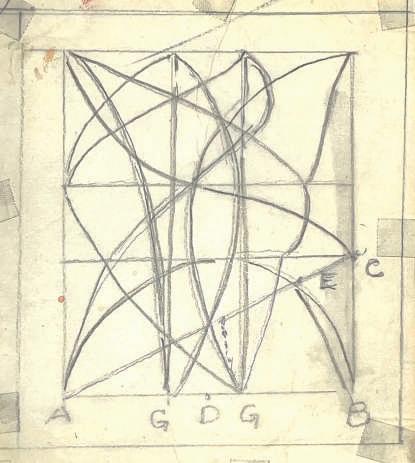
Biehle’s Diagram of the Arabesque Line
lines. Around this structure, diagonal lines and curving arabesques fracture the surface into a series of sharp-edged, geometric shapes, so the surface reads like a pane of shattered, crystalline glass.
Biehle merged his push toward abstraction with his admiration for Van Gogh in The Road to Dover (cat. 58), a tumultuous night scene of rolling hills and haystacks writhing beneath a cobalt sky and glowing yellow stars. Intenselycolored, electric brushstrokes transform the Ohio landscape into an emotive, visionary experience. A different transformation occurs in Farm near Canal Road (cat. 59) through a fusion of observed nature and Cubist-Futurist design. Here, Biehle overlaid the rolling hills and farm houses with a grid of overlapping, intersecting planes of translucent color, infusing the composition with dynamic energy and movement.
In the 1950s and 1960s, as Biehle worked
toward a greater synthesis of modernist theory and decorative design, his paintings approached complete abstraction. The houses and trees in Buescher Farm Abstraction (Memorial to William Sommer) (cat. 64) are barely recognizable. The degree of abstraction now exceeds anything in his Brandywine or Berlin Heights paintings. Conventional recessional space is replaced by a mosaic of flat, brilliantly-colored shapes, in which space is suggested solely through the optical interaction of abstract color. Biehle took a different approach in Untitled (Labyrinth Lines and Faces) (cat. 65). Continuously flowing white lines trace abstract patterns that occasionally suggest a face or figure, perhaps an artist at work in the center. Such paintings attest to Biehle’s lifelong devotion to drawing, here combined with his unique synthesis of modernist and decorative design principles.
After retiring from commercial lithography in 1952, Biehle continued painting and remained active in the city’s cultural life. He contributed to the Kokoon Klub until its dissolution in 1958 and exhibited in the Cleveland Museum of Art’s annual May Shows until 1977. He never abandoned his roots and was fortunate to live in a city that supported local artists. Like many of his colleagues, he sustained himself by commercial work or teaching, which allowed him to explore his own modernist visions through independent creative work. Biehle died in 1979 at age ninety-four, leaving a legacy of devotion to his craft, originality, resilience, and vision. He remains an artist deserving of greater national recognition.
1 Although art historians in Cleveland have published studies of the modernist movement in Northeast Ohio, the subject remains largely unacknowledged in standard histories of American art. For an alternative view, see William H. Robinson and David Steinberg, Transformations in Cleveland Art, 1796-1946 (Cleveland Museum of Art, 1996), and Henry Adams, Painting in Pure Color: Modern Art in Cleveland before the Amory Show, 1908-1913 (Cleveland Artist’s Association, 2013).
2 Rotraud Sacherlotzky, Frederick A. Biehle, O. P. Reed, and Ellen Landau, August F. Biehle, Jr., Ohio Landscapes (Mather Gallery, Case Western Reserve University, 1986), 37.
3 Biehle’s office building no longer exists. The site is currently occupied by the Sherwin-Williams Breen Technology Center at 601 Canal Road.
4 While the second version is sometimes dated to the 1930s, the heavy forms and dark palette seem closer to Biehle’s paintings of 1908-1910. The dating of Biehle’s paintings is often speculative because many are signed but not dated. Approximate dates may be assigned based on comparison with dated works, exhibition catalogues, sketchbooks, and related documents.
5 Some sources say Biehle made his second trip to Europe in 1910. Henry Adams dates the trip to January 1911. See Adams, 75.
6 Biographical information about Biehle in this essay is derived largely from Sacherlotzky et al., 24, 50-51.
7 Adams, 84.
8 Some sources say Biehle joined the Kokoon Klub in 1912, however, club records place the date at 1914. See Henry Adams and Lawrence Waldman, Out of the Kokoon (Cleveland Public Library, 2011), 158.
9 Officially titled the “Annual Exhibition of Cleveland Artists and Craftsmen,” this spring exhibition, popularly known as the “May Show,” was discontinued after 1993.
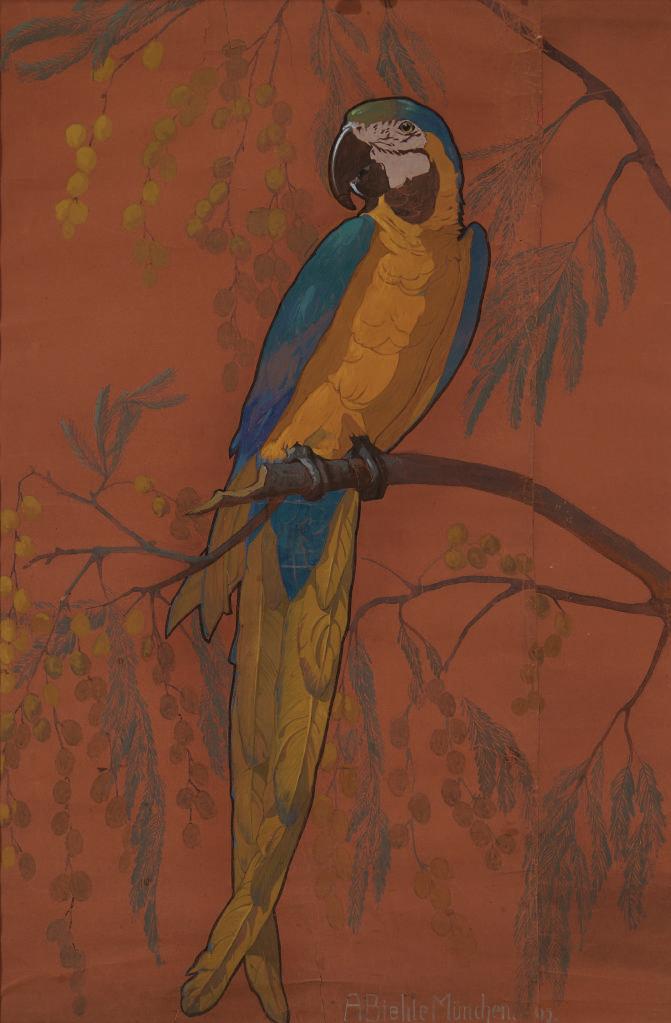
Signed and dated lower right
'München' 1905
42 x 28 inches

Fire Tug on the Cuyahoga River, date unknown, after a painting from 1908.
Oil on canvas
Signed lower right
36.5 x 34.5 inches
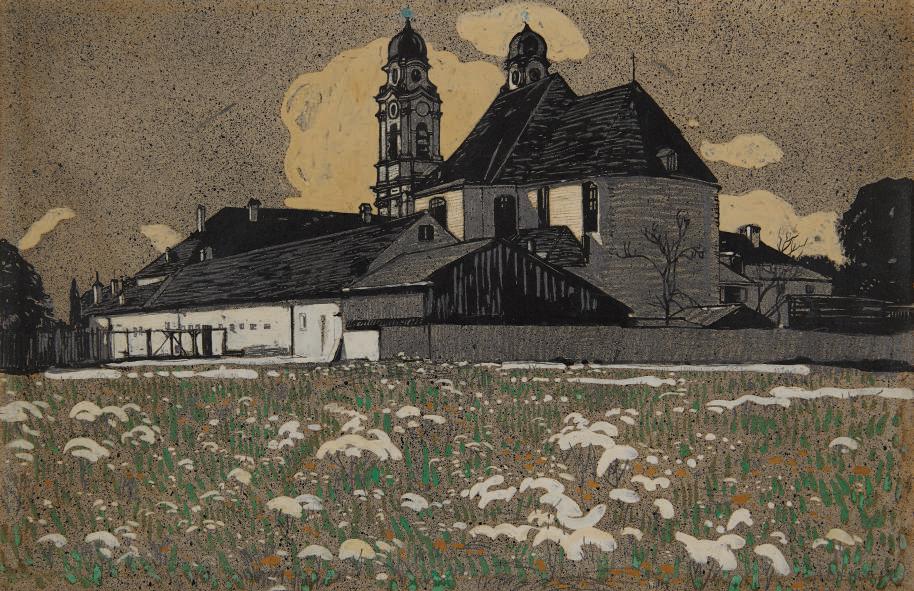
Town Chapel near Munich, Germany, 1912
Gouache, ink and graphite on paper
Signed lower right
15.5 x 23.5 inches
Exhibited:
Landscapes from Germany, Korner and Wood Gallery, Cleveland, 1912
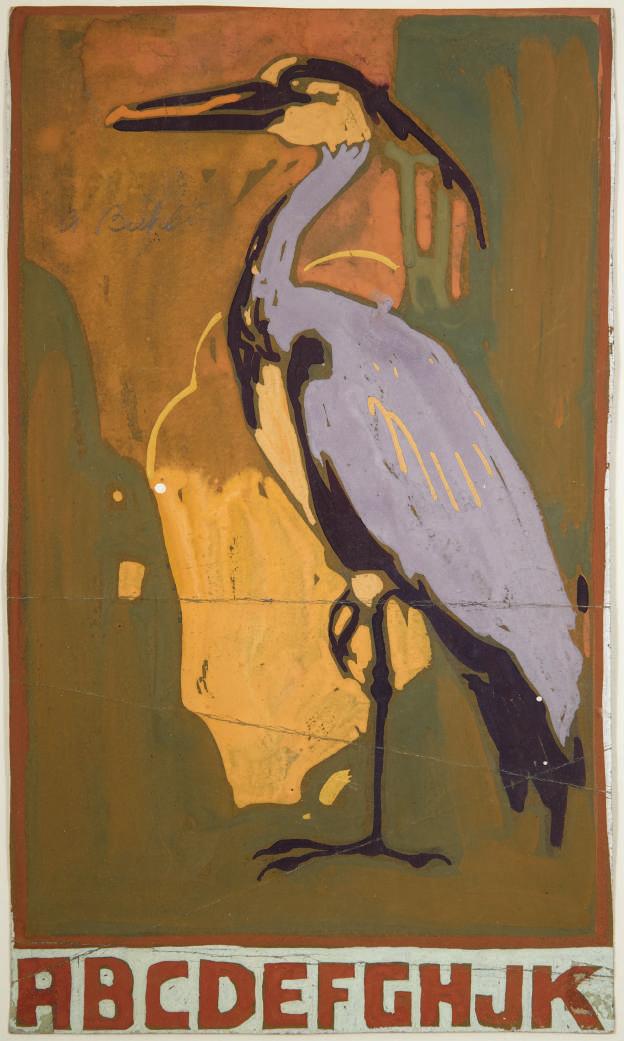

5. Castle in Germany, 1912
Gouache on paper
Signed lower right, dated lower left
24 x 19 inches
Exhibited:
August F. Biehle, Jr. Ohio Landscapes, The Mather Gallery, CWRU, Cleveland, Ohio October - November, 1986
European Vision, American Eye, Stocker Center Gallery, Lorain Community College, October - November, 1990
August F. Biehle, Jr., Styles and Imagery, Canton Museum of Art, August - October 1999
Cleveland Artist Foundation Pioneering Modernism: Post Impressionism in Cleveland, 1908-1913, May

Oil on board
Signed lower right
32 x 25 inches

7.
House in the Moor near Munich, 1912
Gouache on paper laid on cardboard
Signed and dated lower right
21 x 25 inches
Exhibited:
August F. Biehle, Jr. Ohio Landscapes, The Mather Gallery, CWRU, Cleveland, Ohio October - November, 1986
Paradise Lost: August F. Biehle, Jr. and Zoar, Cleveland Artist Foundation, January - March 2012
Pioneering Modernism: Post Impressionism in Cleveland, 1908-1913, Cleveland Artist Foundation, May - July 2013
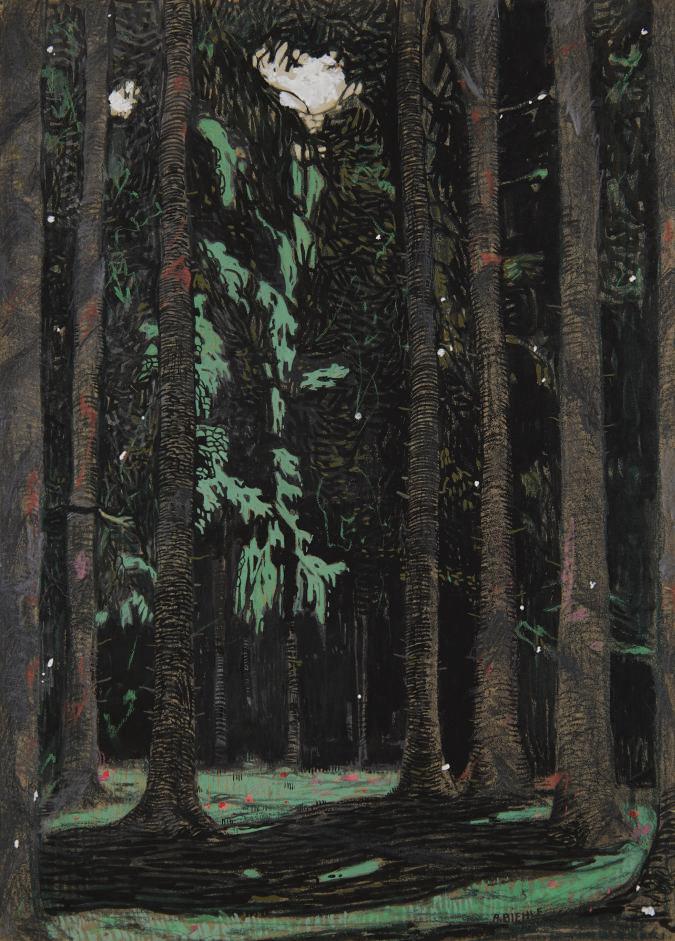
8.
Forest in Germany, c. 1912
Gouache, ink, litho crayon and graphite on paper laid on cardboard
Signed lower right
23.5 x 17.5 inches
Exhibited:
August F. Biehle, Jr. Ohio Landscapes, The Mather Gallery, CWRU, Cleveland, Ohio October - November, 1986
August F. Biehle, Jr., Styles and Imagery, Canton Museum of Art, August - October 1999

Signed lower right 21.75 x 30 inches
Exhibited: Cleveland: A Cultural Center, WOLFS Gallery, Cleveland, OH July - August 2018

10.
The Deposition, 1913
Oil on board
Signed lower left 21 x 29.5 inches
Exhibited:
August F. Biehle, Jr. Ohio Landscapes, The Mather Gallery, CWRU, Cleveland, Ohio October-November, 1986
European Vision, American Eye, Stocker Center Gallery, Lorain Community College, October - November, 1990
Transformations in Cleveland Art 1796 - 1946, Cleveland Museum of Art, May - July, 1996
August F. Biehle, Jr., Styles and Imagery, Canton Museum of Art, August - October 1999
Paradise Lost: August F. Biehle, Jr. and Zoar, Cleveland Artist Foundation, January - March 2012
Pioneering Modernism: Post Impressionism in Cleveland, 1908-1913, Cleveland Artist Foundation, May - July 2013

c. 1915
Gouache, watercolor and ink on cardboard
Signed lower left 12 x 14 inches
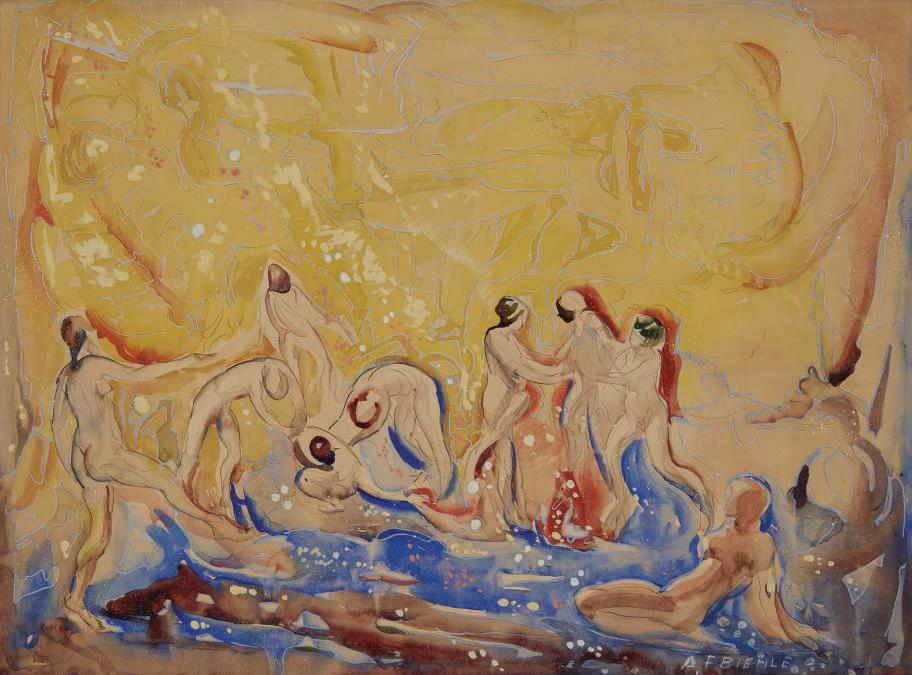
12.
Bathers on Yellow, c. 1915-21
Gouache, watercolor and colored pencil on paper
Signed lower left 18 x 24 inches
Exhibited: August F. Biehle, Jr., Styles and Imagery, Canton Museum of Art, August - October 1999

Signed lower left
11.5 x 13 inches
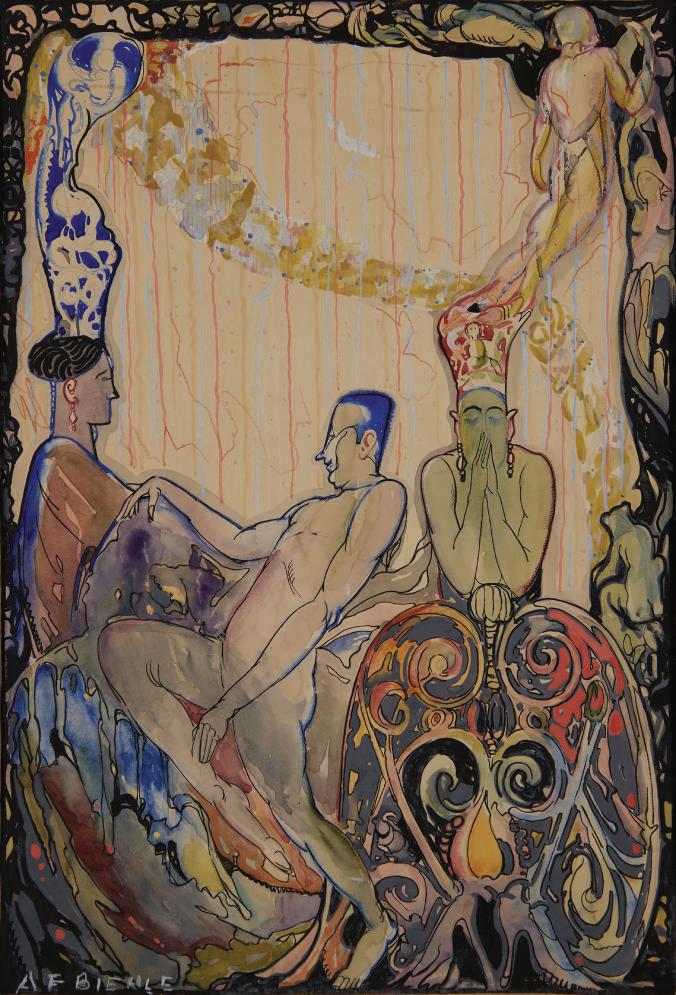
Sketch for Kokoon Klub, Souvenir/Poster, c. 1914-1919
Gouache, watercolor and ink on paper
Signed lower left
20.5 x 14.5 inches
Exhibited:
Hired Hands: Then and Now, Cleveland's Illustrators 1920-2002, Beck Center for the Arts, Virginia Foley Gallery, Cleveland, Ohio, December 2002 - March 2003
Bohemian Chrysalis: Unveiling Cleveland's Infamous Kokoon Klub, Canton Museum of Art, November 2024 - March 2025
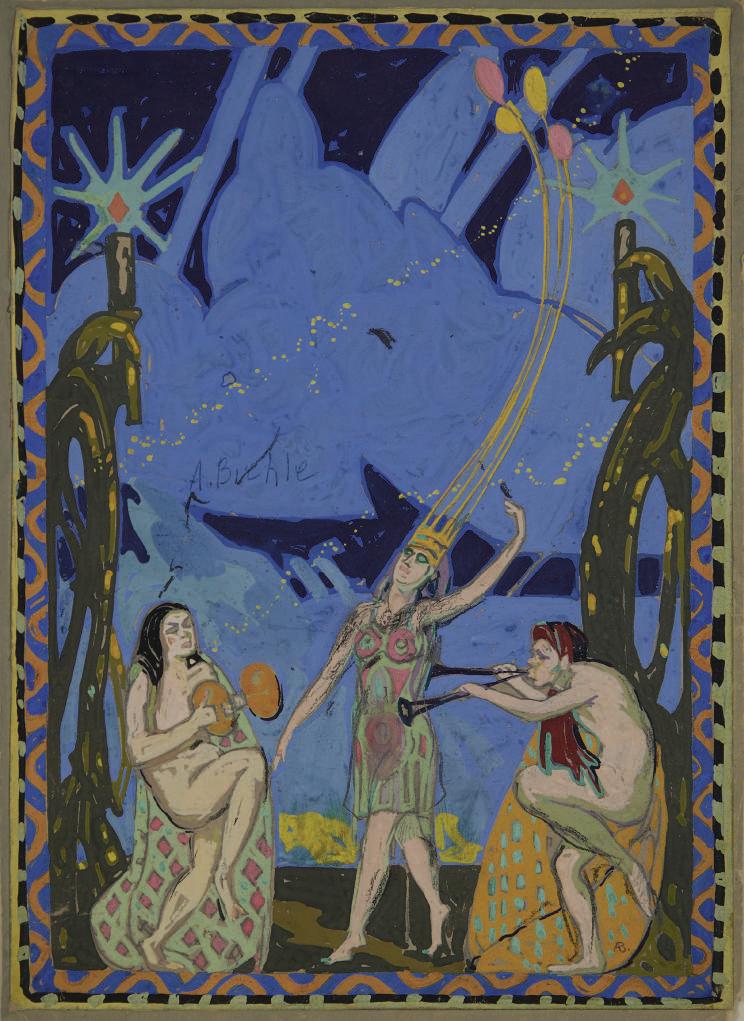
15.
Figural Group on Blue, Cymbals and Flutes, Kokoon Klub
Souvenir/Poster, c. 1917-20
Gouache and graphite on paper glued to board
Signed middle left, initialed lower right 11 x 8 inches
Exhibited:
Bohemian Chrysalis: Unveiling Cleveland's Infamous Kokoon Klub, Canton Museum of Art, November 2024 - March 2025

Watercolor and gouache on paper
Signed lower left 24 x 16 inches
Exhibited:
2024 - March 2025


16b.
Decorated Panel, 1926
Gouache, watercolor and ink on board
Signed lower left 18 x 39 inches
Exhibited:
The 8th Annual May Show, Cleveland Museum of Art, 1926

Watercolor and gouache on illustration board
Signed lower left, dated lower right 39.5 x 18.5 inches
Exhibited: Cleveland: A Cultural Center, WOLFS Gallery, Cleveland, OH July - August 2018

18.
Sketch for Kokoon Klub Souvenir Book, 1926
Gouache, watercolor and ink on paper
19 x 14 inches
Exhibited:
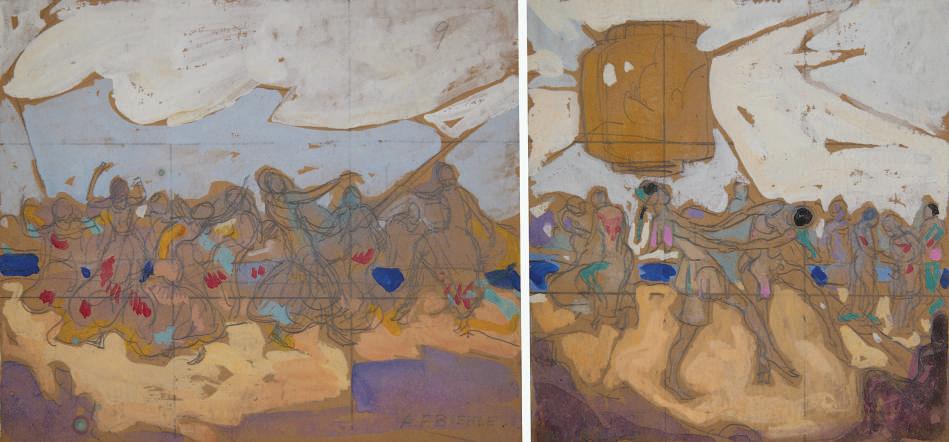
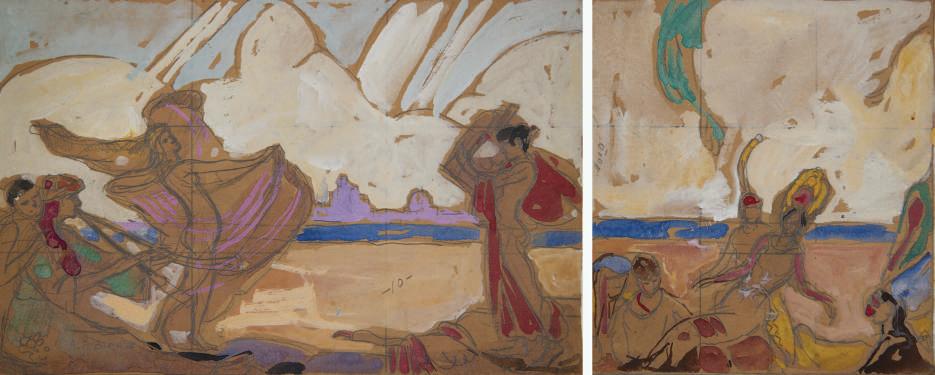
20.
Mural Sketch for a Kokoon Klub Ball, 1926
Gouache and graphite on board
6.5 x 16 inches
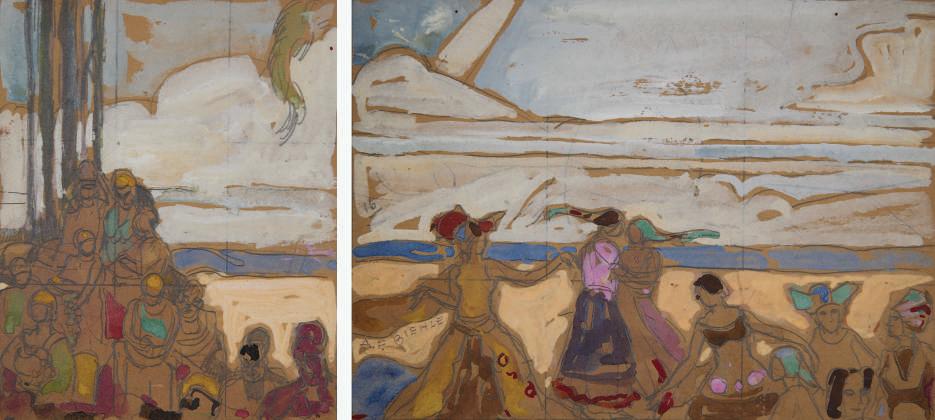
Mural Sketch for a Kokoon Klub Ball, 1926
Gouache and graphite on board
6.5 x 14.5 inches

22.
The Proposal, Sketch for Kokoon Klub Poster, c. 1928
Gouache on board
Signed lower right
19.5 x 13.5 inches
Exhibited:
Unveiling Cleveland's
, Canton Museum of Art, November 2024 - March 2025

Dancing Figures, Sketch for Kokoon
Gouache and graphite on paper
Signed lower right
8 x 11 inches
Exhibited:

Costume Bal Masque, Kokoon Klub Poster, 1937
Lithograph on paper 21.25 x 13.5 inches
Exhibited:
Hired Hands: Then and Now, Cleveland's Illustrators 1920-2002, Beck Center for the Arts, Virginia Foley Gallery, Cleveland, Ohio, December 2002-March 2003
Out of the Kokoon: Cleveland's Festival of Art and Dance, 1911-1938, Cleveland Public Library, Cleveland, Ohio, August - December 2011 Bohemian Chrysalis: Unveiling Cleveland's Infamous Kokoon Klub, Canton Museum of Art, November 2024 - March 2025

Mural Study with Mushrooms, 1952
Gouache on paper
Signed and dated lower right
12.5 x 23 inches

Signed lower right 19 x 15 inches

Signed lower left 16 x 11.5 inches
Exhibited: Celebrating the Cleveland School, WOLFS Gallery, Cleveland, OH October-November 2024

Road through Berlin Heights, c. 1919
Gouache on paper
Signed lower right 14 x 18 inches

Gouache on paper
Signed lower right 18 x 14 inches
Exhibited: August F. Biehle, Jr. Ohio Landscapes, The Mather Gallery, CWRU, Cleveland, Ohio October - November, 1986

Signed lower right 17 x 23 inches

31.
Haystacks at Berlin Heights, c. 1920
Oil on masonite
Signed lower left
28.5 x 39.5 inches
Exhibited:
August F. Biehle, Jr. Ohio Landscapes, The Mather Gallery, CWRU, Cleveland, Ohio October - November, 1986
Henry Keller's Summer School in Berlin Heights, Cleveland Artist Foundation, February - May, 1991
August F. Biehle, Jr., Styles and Imagery, Canton Museum of Art, August - October 1999

Signed and dated lower left 24 x 18 inches

Woods Interior, Berlin Heights, 1920
Gouache and colored pencil on paper
Signed and dated lower right 17 x 23 inches

34.
Berlin Heights Landscape, 1921
Gouache on paper
Signed lower right
17.5 x 23.5 inches
Exhibited:
August F. Biehle, Jr. Ohio Landscapes, The Mather Gallery, CWRU, Cleveland, Ohio October - November, 1986
European Vision, American Eye, Stocker Center Gallery, Lorain Community College, October - November, 1990
Henry Keller's Summer School in Berlin Heights, Cleveland Artist Foundation, February - May, 1991

Colored
Signed lower right 11 x 14 inches
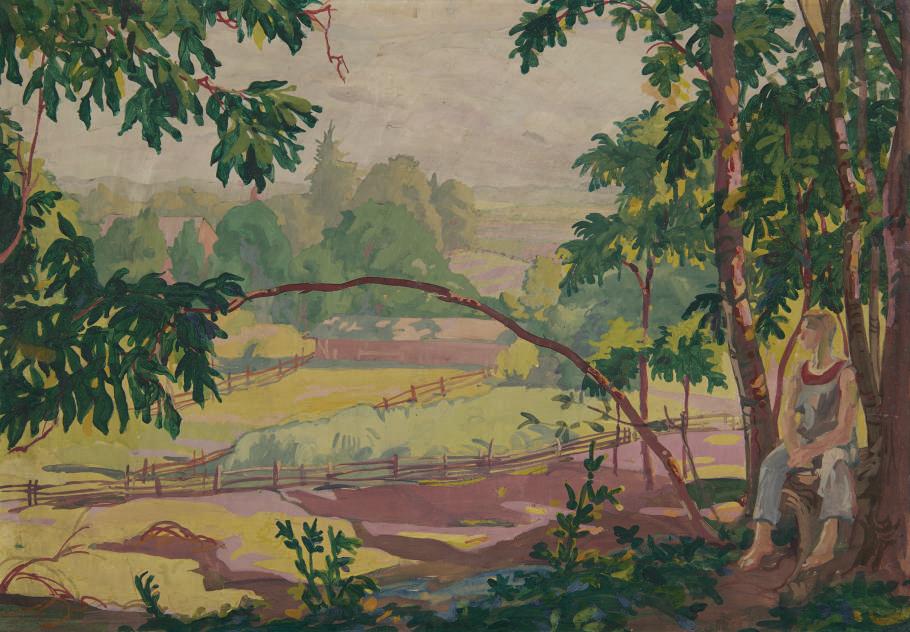
36.
Berlin Heights Landscape with Figure, c. 1924
Gouache on paper
20 x 28 inches

Landscape, Berlin Heights, 1924
Oil on masonite
Signed lower left
35.5 x 50.5 inches
Exhibited:
The 6th Annual May Show, Cleveland Museum of Art, 1924

Gouache
Signed lower right 18 x 24 inches
Exhibited:
August F. Biehle, Jr. Ohio Landscapes, The Mather Gallery, CWRU, Cleveland, Ohio October - November, 1986
European Vision, American Eye, Stocker Center Gallery, Lorain Community College, October - November, 1990
Paradise Lost: August F. Biehle, Jr. and Zoar, Cleveland Artist Foundation, January - March 2012

Signed and dated lower right 18 x 23 inches
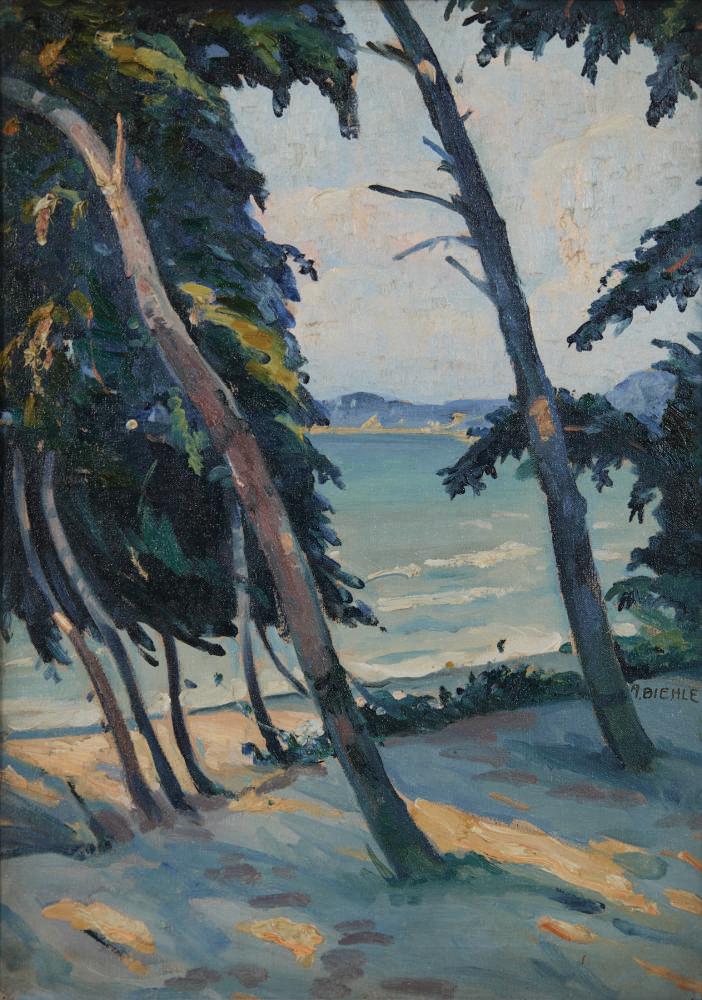
40.
Lake Erie Shore near Berlin Heights, 1922
Oil on canvas
Signed lower right
28.5 x 22 inches
Exhibited:
The 4th Annual May Show, Cleveland Museum of Art, 1922
August F. Biehle, Jr. Ohio Landscapes, The Mather Gallery, CWRU, Cleveland, Ohio October - November, 1986
European Vision, American Eye, Stocker Center Gallery, Lorain Community College, October - November, 1990

Signed lower right 18 x 12 inches

Signed lower right 22 x 30 inches

Mill on the Canal, Zoar, Ohio, c. 1920 Oil on canvas
Signed upper right 32 x 39 inches
Exhibited: August F. Biehle, Jr. Ohio Landscapes, The Mather Gallery, CWRU, Cleveland, Ohio October - November, 1986

44.
Brewery, Zoar, Ohio, 1920
Gouache, litho crayon and graphite on paper
Signed and dated lower right 14 x 20 inches
Exhibited:
Paradise Lost: August F. Biehle, Jr. and Zoar, Cleveland Artist Foundation, January - March 2012

45.
Overgrown Hermitage along Road to Zoar, 1920
Gouache, litho crayon and graphite on paper
Signed and dated lower left 18 x 24 inches
Exhibited:
August F. Biehle, Jr. Ohio Landscapes, The Mather Gallery, CWRU, Cleveland, Ohio October - November, 1986
Paradise Lost: August F. Biehle, Jr. and Zoar, Cleveland Artist Foundation, January - March 2012

Signed lower right 14 x 19 inches

Signed lower right 14 X 19 inches

Farm Landscape through the Trees, Zoar, c. 1920
Gouache, litho crayon and graphite on paper
Signed lower right 18 X 24 inches

49.
Landscape in West Virginia, 1922
Gouache, litho crayon and graphite on paper
Signed lower right
19 x 17.5 inches
Exhibited:
August F. Biehle, Jr. Ohio Landscapes, The Mather Gallery, CWRU, Cleveland, Ohio October - November, 1986
August F. Biehle, Jr., Styles and Imagery, Canton Museum of Art, August - October 1999
Paradise Lost: August F. Biehle, Jr. and Zoar, Cleveland Artist Foundation, January - March 2012
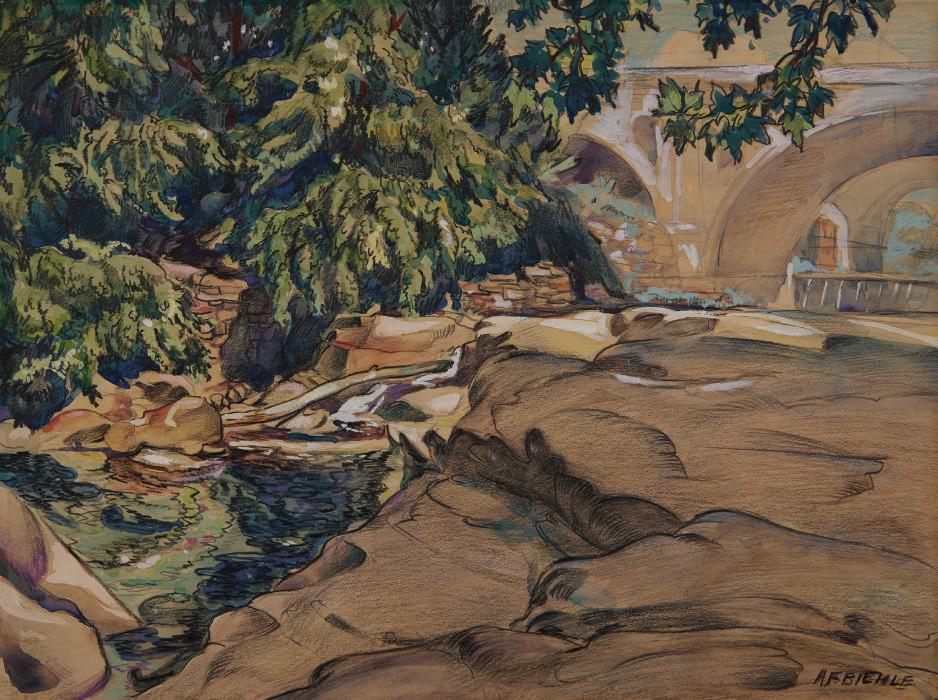
Signed lower right 14 x 19 inches
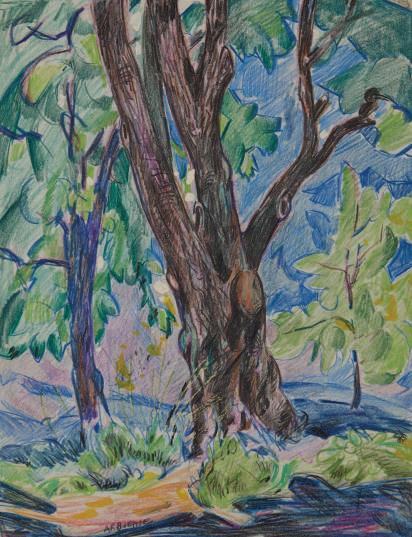
51.
Trees, c. 1928
Colored pencil on paper
Signed lower left 14 X 11 inches

52.
Through the Trees, 1928
Gouache, ink, litho crayon and graphite on paper
Signed lower right
20 x 15 inches

Cleveland Whitefish Company, c. 1913
Gouache, watercolor and graphite on paper
Signed lower right 13.5 x 19.5 inches
Exhibited:
August F. Biehle, Jr. Ohio Landscapes, The Mather Gallery, CWRU, Cleveland, Ohio October - November, 1986
European Vision, American Eye, Stocker Center Gallery, Lorain Community College, October - November, 1990

Gouache,
Signed lower right 14 x 20 inches
Exhibited: August F. Biehle, Jr. Ohio Landscapes, The Mather Gallery, CWRU, Cleveland, Ohio October - November, 1986

Signed lower right
18 x 24 inches

56.
The Struggle, c. 1936
Pastel and graphite on illustration board
17 x 26 inches
Exhibited: The 23rd Annual May Show, Cleveland Museum of Art, 1936
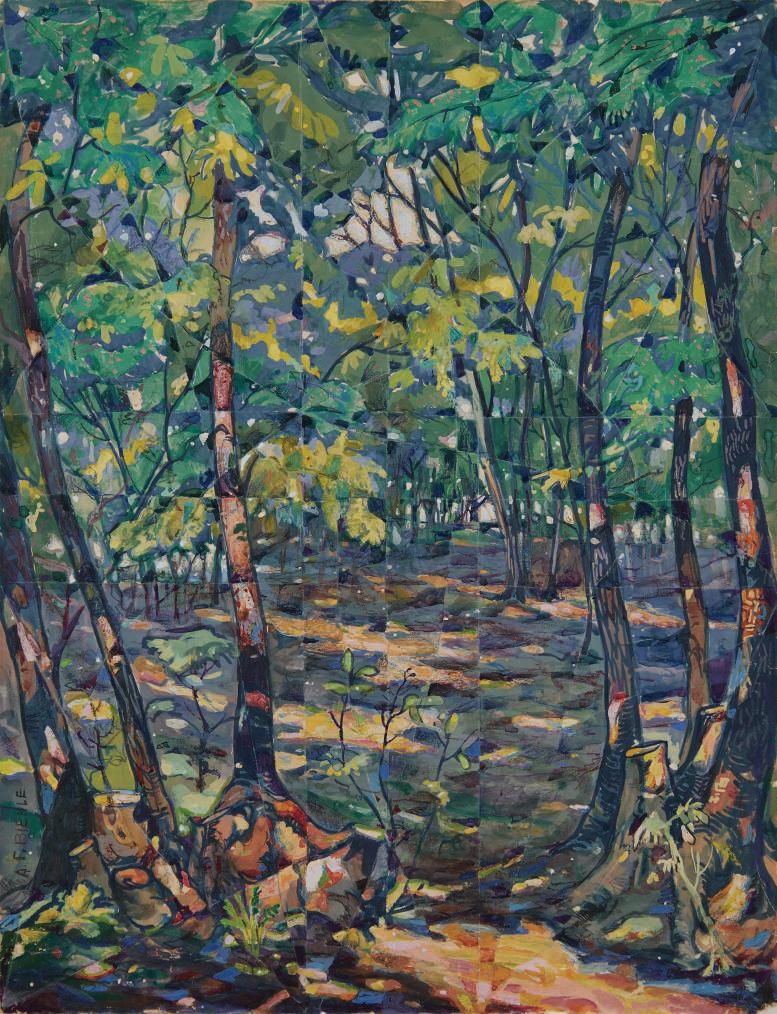
Signed lower left 24 x 18 inches
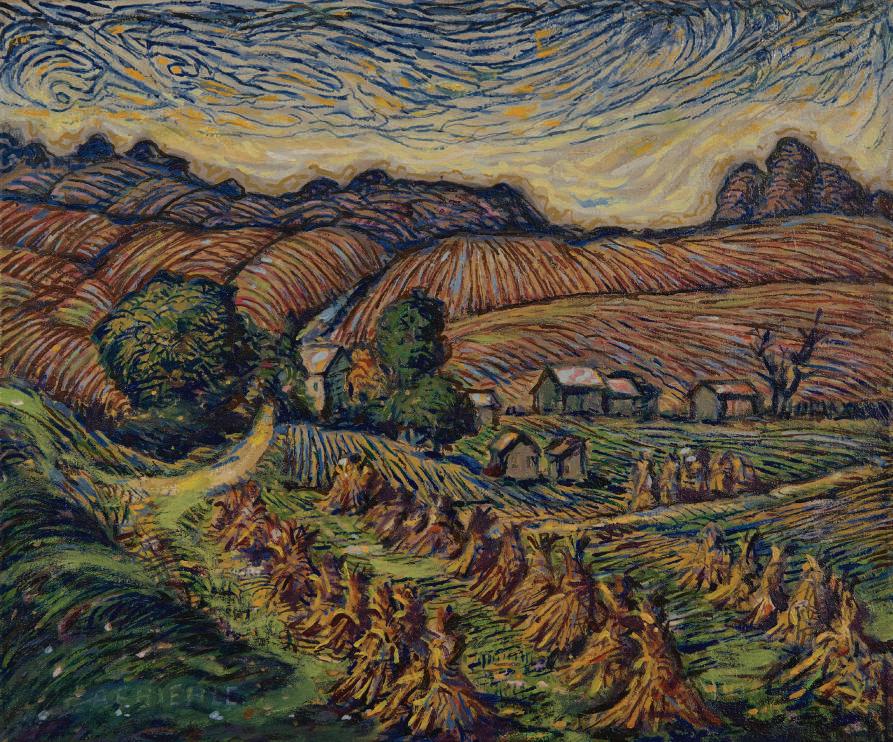
58.
The Road to Dover, c. 1932 Oil on canvas
Signed lower left 16 x 17 inches
Exhibited:
August F. Biehle, Jr. Ohio Landscapes, The Mather Gallery, CWRU, Cleveland, Ohio October - November, 1986
Paradise Lost: August F. Biehle, Jr. and Zoar, Cleveland Artist Foundation, January - March 2012
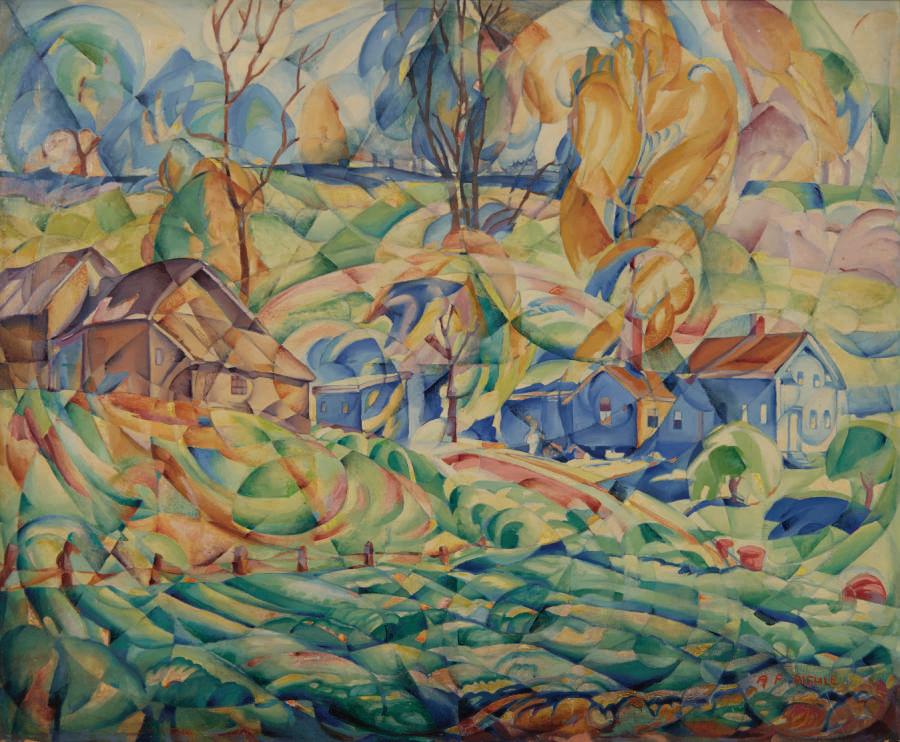
59.
Oil on board
Signed lower right
32 x 39 inches
Exhibited:
The 53rd Annual May Show, Cleveland Museum of Art, 1972
August F. Biehle, Jr. Ohio Landscapes, The Mather Gallery, CWRU, Cleveland, Ohio October - November, 1986
European Vision, American Eye, Stocker Center Gallery, Lorain Community College, October - November, 1990
Transformations in Cleveland Art 1796 - 1946, Cleveland Museum of Art, May - July, 1996
August F. Biehle, Jr., Styles and Imagery, Canton Museum of Art, August - October 1999
Ohio and Modernism, Keny Gallery, Columbus, Ohio, December 2010 - January 2011

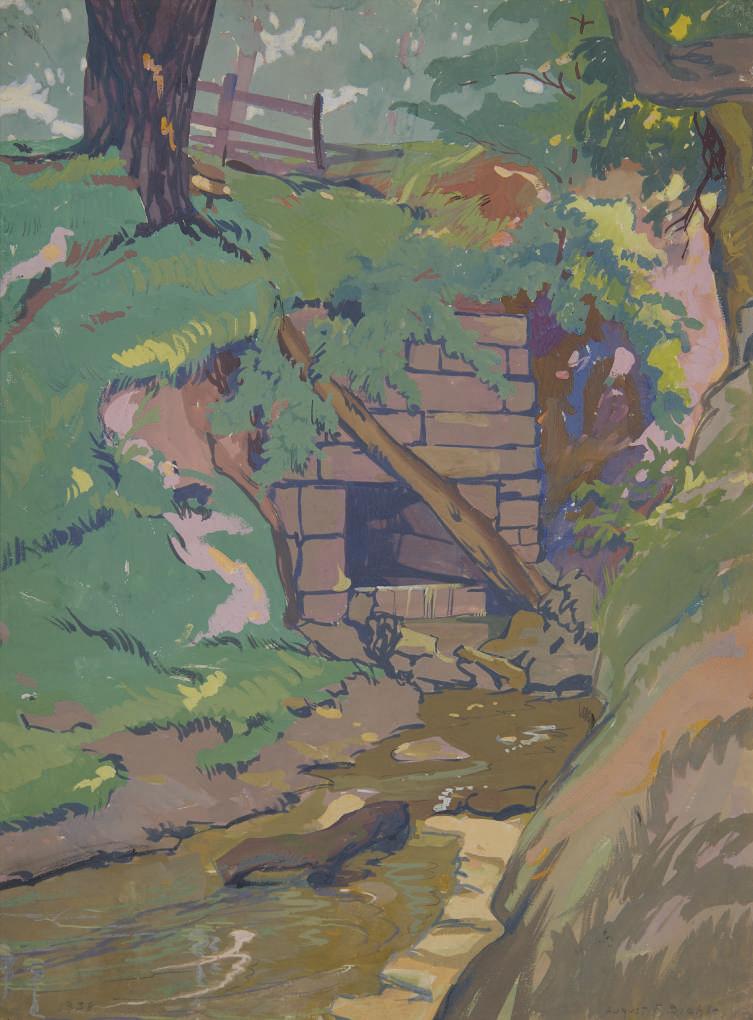
Signed lower right, dated lower left
23.5 x 17.5 inches
Exhibited:
August F. Biehle, Jr., Styles and Imagery, Canton Museum of Art, August - October 1999
Paradise Lost: August F. Biehle, Jr. and Zoar, Cleveland Artist Foundation, January - March 2012
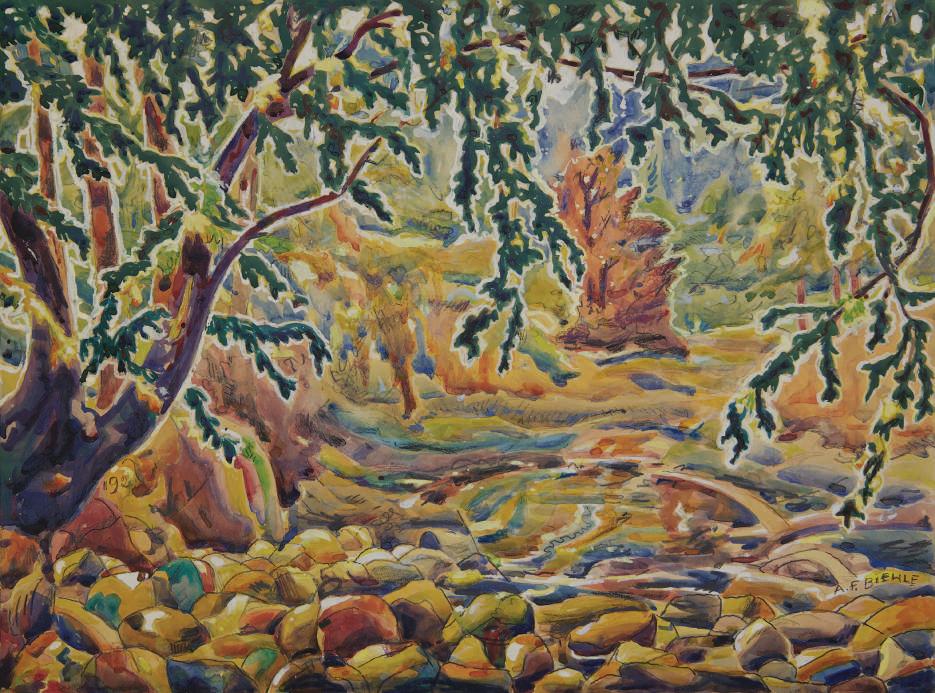
lower right, dated lower left 18 x 24 inches
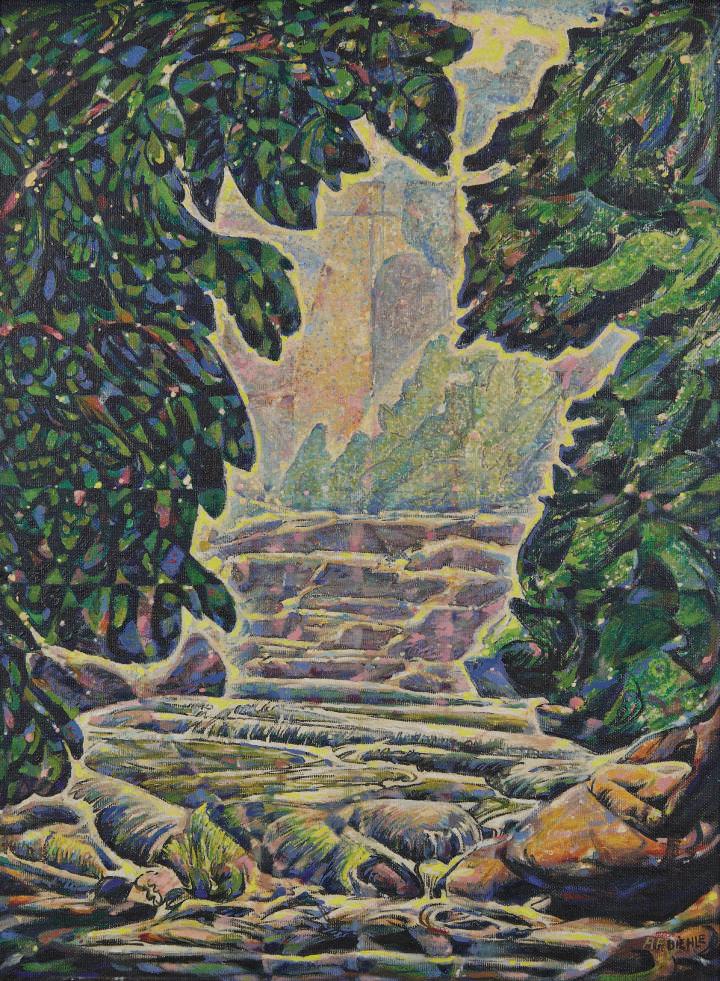
Signed lower right
36 x 27.5 inches
Exhibited:
The 35th Annual May Show, Cleveland Museum of Art, 1954
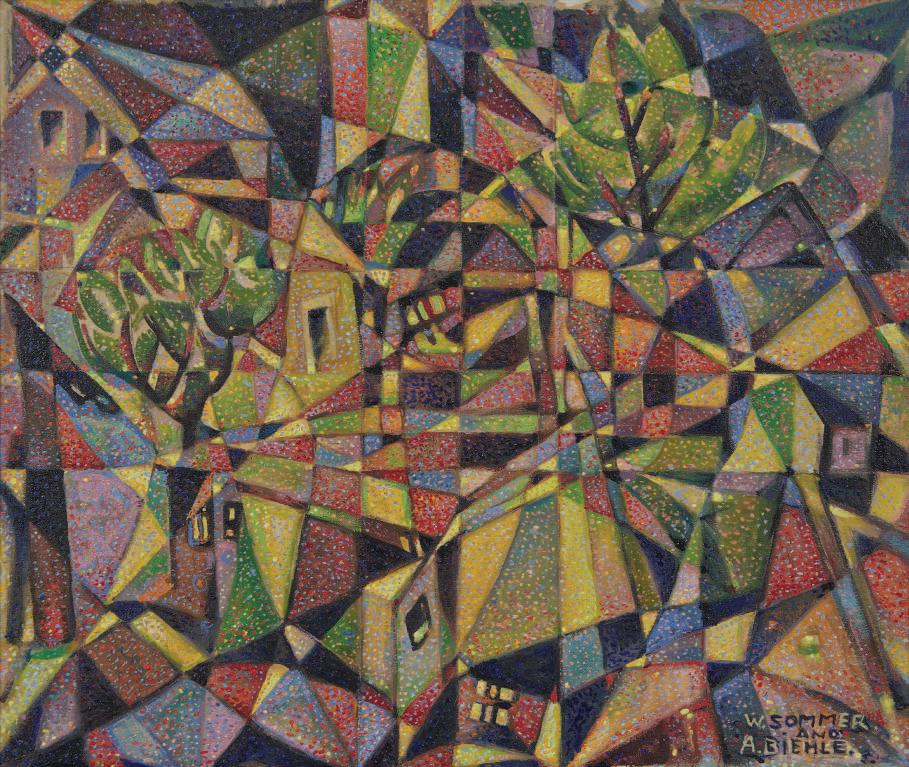
Signed lower right 'A. Biehle and W. Sommer'
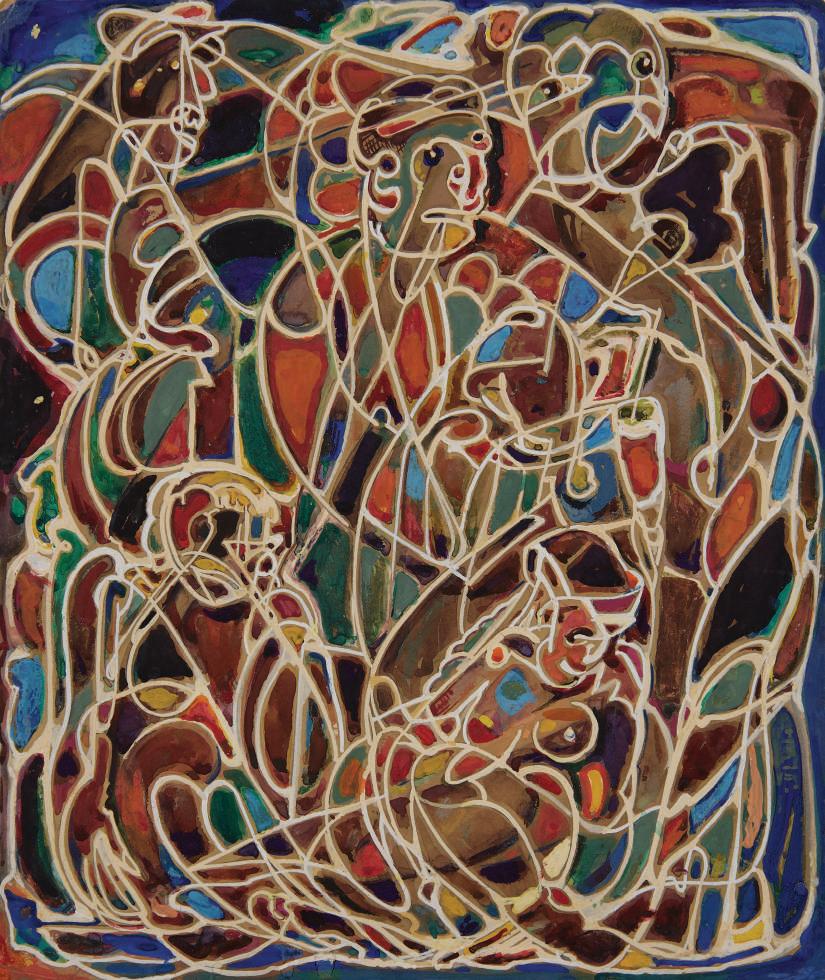

Signed lower right 37.5 x 26 inches


Gouache, graphite and colored pencil on paper
Signed and dated center
16.5 x 11.5 inches

Watercolor, ink and graphite on paper
Signed lower right, dated center
13.5 x 10 inches

Signed lower right
28 x 20 inches

Signed lower right
36 x 34 inches
Korner and Wood Gallery, Cleveland, September 1912
Landscapes from Germany
Rohrheimer – Brooks Studios, Cleveland, Fall 1912
Landscapes from Germany
Taylor Gallery, Cleveland, October 1912
Poster Designs from Germany
Lindner’s Gallery, Cleveland, February 1918
Landscapes, Portraits and Decorative Designs
Laukhuff’s Book and Art Shop, Cleveland, April – May 1918
Smaller Works
Cleveland Playhouse, Cleveland, November 1918
Landscapes, Portraits and Decorative Designs
Kokoon Arts Club, Cleveland, November – December 1919
Portraits, Murals, Landscapes, Decorative Panels
Kokoon Arts Club, Cleveland, November 2 – 21, 1920 Zoar Landscapes
Kokoon Arts Club, Cleveland, November 1922
Senator Thomas Schmidt presents stories of Zoar
Kokoon Arts Club, Cleveland, February – March 6, 1926 One Man Show (Still Life, Landscapes, Decorative Works)
Lindner’s Gallery, Cleveland, February 1 – 28, 1928
Watercolors, Oils, Drawings
Kokoon Arts Club, Cleveland, December 14 – 30, 1931
Paintings, Watercolors, and Oils: Including New Works from Zoar Done This Past Summer
Eastman Bolton Galleries, Cleveland, December 1932
Watercolors, Lithographs
Kokoon Arts Club, Cleveland, November, 3 – 14, 1936
One Man Show
Little Gallery of Cleveland College, Cleveland, March 1940
One Man Show
Kokoon Arts Club, Cleveland, August 1942
Figures and Portraits
American Social Turnverein, Cleveland, 1946
One Man Show
The Ohio State Archaeological and Historical Society, North Gallery, November 1951
Zoar Scenes
Cleveland Society of Artists and Craftsmen, January 1955
One Man Show
Fenn College Library Gallery, February 1 – March 1, 1962
Thirty Five Paintings
The Mather Gallery, CWRU, Cleveland, October 24 – November 15, 1986
August F. Biehle, Jr., Ohio Landscapes
The Ohio Historical Society, Zoar Village, August 2 – October 3, 1986; April 4 – July 26, 1987
August F. Biehle, Jr.: Views of Zoar
Stocker Center Gallery, Lorain County Community College, October 21 – November 21, 1990
European Vision / American Eye: The Life and Art of August F. Biehle, Jr. 1885-1979
Canton Museum of Art, Canton, Ohio, August 20 – October 29, 1999
August F. Biehle, Styles & Imagery
Beck Center for the Arts, January 13 – March 10, 2012
Paradise Lost: August F. Biehle, Jr. and Zoar
Taylor Gallery, Cleveland, 1914
American Modernism
Hatch Art Studios and Galleries, March 1915
Kokoon Arts Klub: Special Members Exhibition
*Biehle exhibited in eight group exhibitions of the Kokoon Klub, the last in 1942
Laukhuff’s Book and Art Shop, Cleveland, December 1916
Etchings and Watercolors
Cleveland Playhouse, Cleveland, March 1918 Watercolors
Cleveland Museum of Art, May 8 – June 6, 1918
Special Exhibition of Painting and Sculpture
The Cleveland Museum of Art, May 5 – June 27, 1920
Second Annual Exhibition of Cleveland Artists and Craftsmen
*Biehle exhibited in forty seven of these annual exhibitions, popularly known as the May Show, the last in 1977.
Cleveland Museum of Art, June 10 – July 11, 1921
Special Exhibit of Contemporary American Painting
*Biehle exhibited four times in this annual exhibition, the last in 1931
Cleveland Museum of Art, January 15 – February 15, 1925
Second Exhibit of American Watercolors and Pastels
*Biehle exhibited six times in this annual exhibition, the last in 1937
Ohio State Fair, Columbus Ohio, September 1927
Works from New York, Boston, and Ohio cities
Cleveland Museum of Art, Cleveland Public Library, March 16 – April 15, 1934 Federal Arts Commission (traveled to Washington, DC)
Whitney Museum of Art, New York City, March 17 – April 16, 1937 Exhibition of Paintings and Prints by Cleveland Artists
Butler Institute of American Art, Youngstown 1954
19th Annual Midyear Painting Competition
*Biehle exhibited three times in this annual exhibition, the last in 1967
Regional Arts Gallery, New York City, December 31 – January 20, 1956
August, Frederick, Helen Biehle
The Women’s City Club, Cleveland, Ohio, February 3 – February 27, 1959
August, Frederick, Helen Biehle
Cleveland Engineering and Scientific Center, Cleveland, January 1964
Artists and Craftsmen Association
Cleveland Museum of Art, April 23 – June 16, 1968
50th Anniversary May Show Retrospective
Cleveland Museum of Art, July 13 – August 21, 1977
A Study in Regional Taste, the May Show 1919 – 1975
Northeast Ohio Art Museum, Cleveland, 1988
Kokoon Club Exhibition
Cleveland Museum of Art, Cleveland, Ohio, June 28 – August 6, 1989
Cleveland Art Comes of Age
Baldwin Wallace College, Berea, Ohio, February 10 – March 8, 1991
Henry Keller’s Summer School in Berlin Heights
*Traveled to Beachwood Museum, Beachwood, Ohio; Sandusky Cultural Center, Sandusky, Ohio
Columbus Museum of Art, Columbus, Ohio, February 6 – May 15, 1994
Triumph of Color and Light: Ohio Impressionists and Post-Impressionists
Springfield Museum, Springfield, Ohio, January 28 – February 26, 1995
Midwest Realities- Regional Painting 1920-1950
*Traveled to Southern Ohio Museum, Portsmouth, Ohio; Riffe Gallery, Columbus, Ohio
Cleveland Museum of Art, Cleveland, Ohio, May 19 – July 2, 1996 Transformations in Cleveland Art 1796- 1946
Beck Center for the Arts, Cleveland, Ohio, October 2 – November 20, 1998
A Brush with Light, Watercolor Painters of Northeast Ohio
*Traveled to Southern Ohio Museum, Portsmouth, Ohio; the Riffe Gallery, Columbus, Ohio
Beck Center for the Arts, Cleveland, September 30 – November 6, 2000
The Poetics of Place: Charles Burchfield and the Cleveland Connection
*Traveled to the Burchfield-Penney Art Center, Buffalo
Ohio Arts Council’s Riffe Gallery, Columbus, Ohio, March 3 – May 4, 2003
The State of the Arts, A Celebration of Ohio’s Rich Artistic Heritage
*Traveled to Southern Ohio Museum, Portsmouth, Ohio; Springfield Art Museum, Springfield, Ohio
Flint Institute of Arts, Flint, Michigan, November 16 – February 1, 2003
Great Lakes Muse: American Scene Painting from the Upper Midwest 1910-1960
Beck Center for the Arts, Cleveland, September 8 – November 25, 2006
Covering History- Revisiting Federal Art in Cleveland 1933-43
Flint Institute of Arts, Flint, Michigan, May 26 – August 19, 2007
Artists of the Great Lakes: 1910-1960
Massillon Museum, Massillon, Ohio, May 15 – September 12, 2010
Against the Grain: Modernism in the Midwest
*Travelled to Riffe Gallery, Columbus, Ohio; Southern Ohio Art Museum, Portsmouth, Ohio; Wisconsin Art, West Bend, Wisconsin
Beck Center for the Arts, May 24 – July 27, 2013
Pioneering Modernism: Post-Impressionism in Cleveland 1908-1913
WOLFS Gallery, July 11 – August 31, 2018
Cleveland: A Cultural Center
WOLFS Gallery, October - November 2024
Celebrating the Cleveland School
Canton Museum of Art, November 26 – March 2, 2025
Bohemian Chrysalis: Unveiling Cleveland’s Infamous Kokoon Klub
Intro.
Sketch for Costume Bal Masque, Kokoon Klub Poster, 1937
Joe and Elaine Kisvardi
1. Parrot, 1905
Martha and Jim Jacobs
2.
Fire Tug on the Cuyahoga River, date unknown, after a painting from 1908.
Mark and Pam Alder
3.
Town Chapel near Munich, Germany, 1912
Kathy Spresser
4.
Blue Heron with Alphabet, c. 1911
Frederick Biehle and Erika Hinrichs-Biehle
5.
Castle in Germany, 1912
Stephen and Kimberly Biehle
6.
Scene in Southern Germany, c. 1912
Biehle Archives
7.
House in the Moor near Munich, 1912
Mark and Pam Alder
8.
Forest in Germany, c. 1912
Mark and Pam Alder
9. Brandywine Road, c. 1913
Case Western Reserve University
10.
The Deposition, 1913
Frederick Biehle and Erika Hinrichs-Biehle
11.
Dancers, c. 1915
Thomas Bodnar
12.
Bathers on Yellow, c. 1915-21
Nora Biehle and Wayne Walker
13.
Bathers, c. 1920
Frederick Biehle and Erika Hinrichs-Biehle
14.
Sketch for Kokoon Klub, Souvenir/Poster, c. 1914-19
Frederick Biehle and Erika Hinrichs-Biehle
15.
Figural Group on Blue, Cymbals and Flutes, Kokoon Klub
Souvenir/Poster, c. 1917-20
Grace Angelina Files
16.
Clown and Lady, Sketch for Kokoon Klub Poster, c. 1917-21
Nora Biehle and Wayne Walker
16a.
New World Harvest, c. 1919
Frederick Biehle and Erika Hinrichs-Biehle
16b.
Decorated Panel, 1926
Dan Bush and Hilary Gent
17.
Figures with Birds, Sketch for Kokoon Klub Poster, 1925
Dan Bush and Hilary Gent
18.
Sketch for Kokoon Klub Souvenir Book, 1926
Dan Bush and Hilary Gent
19.
Mural Sketch for a Kokoon Klub Ball, 1926
Biehle Archives
20.
Mural Sketch for a Kokoon Klub Ball, 1926
Biehle Archives
21.
Mural Sketch for a Kokoon Klub Ball, 1926
Biehle Archives
22.
The Proposal, Sketch for Kokoon Klub Poster, c. 1928
Stephen and Kimberly Biehle
23.
Dancing Figures, Sketch for Kokoon Klub Poster, c. 1930
Nora Biehle and Wayne Walker
24.
Costume Bal Masque, Kokoon Klub Poster, 1937
Biehle Archives
25.
Mural Study with Mushrooms, 1952
Janet Reta Alder
26.
Forest Scene, c. 1913-15
Beth and Clark Iorio
27.
Woodlands, c. 1913-15
Todd and Ann Gardiner
28.
Road through Berlin Heights, c. 1919
Kathy Spresser
29.
Road to Berlin Heights, c. 1919
Stephen and Kimberly Biehle
30.
Humm Road in Berlin Heights, c. 1921
Beth and Clark Iorio
31.
Haystacks at Berlin Heights, c. 1920
Kathy Spresser
32.
Stone Quarry, Berlin Heights, 1920
Beth and Clark Iorio
33.
Woods Interior, Berlin Heights, 1920
Mark and Pam Alder
34.
Berlin Heights Landscape, 1921
Stephen and Kimberly Biehle
35.
Humm’s Barn, Berlin Heights, c. 1923
Janet Reta Alder
36.
Berlin Heights Landscape with Figure, c. 1924
Biehle Archive
37.
Landscape, Berlin Heights, 1924
Mark and Pam Alder
38.
A View of Berlin Heights, c. 1925
Helen Marie Files
39.
Berlin Heights Looking toward Lake Erie, 1929
Beth and Clark Iorio
40.
Lake Erie Shore near Berlin Heights, 1922
Stephen and Kimberly Biehle
41.
Edge of the Woods, c. 1927
Kathy Spresser
42.
Farm in Berlin Heights, c. 1930
Dannie Sommer
43.
Mill on the Canal, Zoar, Ohio, c. 1920
Janet Reta Alder
44.
Brewery, Zoar, Ohio, 1920
Mark and Pam Alder
45.
Overgrown Hermitage along Road to Zoar, 1920
Janet Reta Alder
46.
Houses in Zoar, c. 1921
Beth and Clark Iorio
47.
Farm Landscape, Zoar, c. 1923
Martha and Jim Jacobs
48.
Farm Landscape through the Trees, Zoar, c. 1920
Martha and Jim Jacobs
49.
Landscape in West Virginia, 1922
Mark and Pam Alder
50.
Meredith Falls, Berea, c. 1929
Beth and Clark Iorio
51.
Trees, c. 1928
Martha and Jim Jacobs
52.
Through the Trees, 1928
Martha and Jim Jacobs
53.
Cleveland Whitefish Company, c. 1913
Nora Biehle and Wayne Walker
54.
Scranton Road in the Flats, c. 1913
Mark and Pam Alder
55.
Republic Steel on the Cuyahoga River, c. 1924
Mark and Pam Alder
56.
The Struggle, c. 1936
Biehle Archives
57.
Illuminated Forest Floor, c. 1930
Janet Reta Alder
58.
The Road to Dover, c. 1932
Alan Fletcher
59.
Farm near Canal Road, c. 1935
Stephen and Kimberly Biehle
60. Decorative Mural, 1934
Mark and Pam Alder
61.
Creek by the Lime Kiln, 1938
Biehle Archives
62.
Creek in the Forest, c. 1949
Martha and Jim Jacobs
63. Berea Woods, Meredith Falls, c. 1954
Helen Marie Files
64. Buescher Farm Abstraction (Memorial to William Sommer), c. 1955
Emily Files and Ashton Rotman
65.
Untitled (Labyrinth Lines and Faces), c. 1965
Biehle Archives
66. Abstract Floral, c. 1960
Beth and Clark Iorio
67.
Bird Abstraction, c. 1965
Martha and Jim Jacobs
68. Hibiscus, 1935
Martha and Jim Jacobs
69. Tulip Still Life, 1970
Beth and Clark Iorio
70. Chrysanthemums and Gerbera Daisies, undated
Martha and Jim Jacobs
71.
Still Life with Zinnias, 1971
Stephen and Kimberly Biehle
William H. Robinson, PhD
WOLFS staff:
Megan Arner
Arianne Flick
Kristen Newell
Thank you to the family of August Frederick Biehle:
Janet Reta Alder
Mark and Pam Alder
Frederick Biehle and Erika Hinrichs-Biehle
Nora Biehle and Wayne Walker
Stephen and Kimberly Biehle
Emily Files and Ashton Rotman
Grace Angelina Files
Helen Marie Files
James and Kendall Files
Lisa Biehle Files and Bruce Files
Alan Fletcher
Beth and Clark Iorio
Martha and Jim Jacobs
Kathy Spresser
Other lenders:
Case Western Reserve University
Thomas Bodnar
Dan Bush and Hilary Gent
Todd and Ann Gardiner
Joe and Elaine Kisvardi
Dannie Sommer
Nikki Mokrzycki, graphic design
Kristen Newell, photography
Clara Wolverton, Cerulean Conservation, LLC
To all those, anonymous and otherwise, who have selflessly contributed to this worthy endeavor – thank you.

